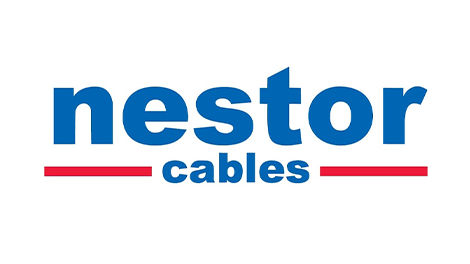Nestor Cables – Our efforts to reduce our carbon footprint in our operations continue
In recent years, we have paid attention to our production’s carbon footprint and have taken measures to reduce it.
This is part of our sustainability work, where we focus, for example, on the environmental friendliness of our operations.
Last year, the carbon dioxide emissions from our Oulu factory were 252.3 tonnes of CO2 eq. In 2022, emissions were 258.29 tonnes of CO2 eq., so we managed to reduce emissions slightly.
Carbon dioxide emissions have decreased by about 6 tonnes, or 2.3%, compared to 2022. Emissions have been reduced particularly in waste management (-1.5 t), electricity usage (-4 t), and diesel-powered forklifts (-0.8 t).
The major contributors to CO2 emissions in our production are electricity production, which generates indirect emissions from renewable hydropower, and the handling of energy, wood packaging, and plastic waste generated in production, which is utilized as energy through incineration.
The recycling rate of waste has remained at the same level compared to 2022, at about 13%. To increase the recycling rate of waste in production, the collection of PE surplus pipes and fibre drums will begin in 2024. These will be sent for recycling into raw material for recycled plastic.
In 2023, we continued the use of carbon-neutral district heating and renewable hydropower as sources of heating energy and electricity. In this way, CO2 emissions have been avoided by 253 tonnes (district heating) and 679 tonnes (electricity).
EMR Analysis
More information on Nestor Cables (Subsidiary of Clearfield Inc. Since July 26, 2022): https://www.nestorcables.com + Nestor Cables was founded in 2007 by cable technology professionals to preserve the Finnish tradition of producing high-quality cable. Currently we are one of the leading developers and manufacturers of fibre optic cable solutions in the Northern Europe.
Our product range includes fibre optic cables, connectivity accessories for fibre optic networks and instrumentation and copper telecommunication cables. Nestor Optimus is our solution to microduct networks. In addition to our product range we offer our customers reliable and flexible deliveries, quick reaction times and efficiency.
More information on Jarmo Rajala (President & Chief Executive Officer, Nestor Cables, Clearfield, Inc.): https://new.emr-online.com/auth/login
More information on Clearfield Inc.: https://www.seeclearfield.com/ + Clearfield, Inc. designs, manufactures and distributes fiber optic management products, helping service providers reduce the high costs associated with deploying, managing, protecting and scaling a fiber optic network to deliver the mobile, residential and business services customers want. Based on the patented Clearview® Cassette, our unique single-architected, modular fiber management platform is designed to lower the cost of broadband deployment and maintenance while enabling our customers to scale their operations as their subscriber revenues increase.
More information on Cheri Beranek (President & Chief Executive Officer, Clearfield, Inc.): https://www.seeclearfield.com/about/management.html + https://www.linkedin.com/in/cheri-beranek-3314277/
EMR Additional Notes:
- Carbon Dioxide (CO2):
- Primary greenhouse gas emitted through human activities. Carbon dioxide enters the atmosphere through burning fossil fuels (coal, natural gas, and oil), solid waste, trees and other biological materials, and also as a result of certain chemical reactions (e.g., manufacture of cement). Carbon dioxide is removed from the atmosphere (or “sequestered”) when it is absorbed by plants as part of the biological carbon cycle.
- Biogenic Carbon Dioxide (CO2):
- Carbon Dioxide released as a result of the combustion or decomposition of organic material, that is biomass and its derivatives. Examples include carbon dioxide released during the combustion of wood and biogas generated by decomposition.
- Biogenic Carbon Dioxide (CO2) and Carbon Dioxide (CO2) are the same. Scientists differentiate between biogenic carbon (that which is absorbed, stored and emitted by organic matter like soil, trees, plants and grasses) and non-biogenic carbon (that found in all other sources, most notably in fossil fuels like oil, coal and gas).
- Carbon Capture and Storage (CCS):
- CCS involves the capture of carbon dioxide (CO2) emissions from industrial processes, such as steel and cement production, or from the burning of fossil fuels in power generation. This carbon is then transported from where it was produced, via ship or in a pipeline, and stored deep underground in geological formations.
- CCS projects typically target 90 percent efficiency, meaning that 90 percent of the carbon dioxide from the power plant will be captured and stored.
- Decarbonization:
- Reduction of carbon dioxide emissions through the use of low carbon power sources, achieving a lower output of greenhouse gasses into the atmosphere.
- Carbon Footprint:
- There is no universally agreed definition of what a carbon footprint is. A carbon footprint is generally understood to be the total amount of greenhouse gas (GHG) emissions that are directly or indirectly caused by an individual, organization, product, or service. These emissions are typically measured in tonnes of carbon dioxide equivalent (CO2e).
- In 2009, the Greenhouse Gas Protocol (GHG Protocol) published a standard for calculating and reporting corporate carbon footprints. This standard is widely accepted by businesses and other organizations around the world. The GHG Protocol defines a carbon footprint as “the total set of greenhouse gas emissions caused by an organization, directly and indirectly, through its own operations and the value chain.”


